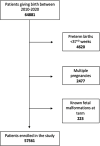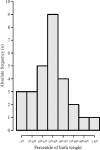Risk of stillbirth in singleton fetuses with advancing gestational age at term: A 10-year experience of late third trimester prenatal screenings of 50,000 deliveries in a referral center in northern Italy
- PMID: 36812250
- PMCID: PMC9946230
- DOI: 10.1371/journal.pone.0277262
Risk of stillbirth in singleton fetuses with advancing gestational age at term: A 10-year experience of late third trimester prenatal screenings of 50,000 deliveries in a referral center in northern Italy
Abstract
Background: The risk of intrauterine death (IUD) at term varies from less than one to up to three cases per 1,000 ongoing pregnancies. The cause of death is often largely undefined. Protocols and criteria to prevent and define the rates and causes of stillbirth are the subjects of important scientific and clinical debates. We examined the gestational age and rate of stillbirth at term in a 10-year period at our maternity hub to evaluate the possible favorable impact of a surveillance protocol on maternal and fetal well-being and growth.
Methods and findings: Our cohort included all women with singleton pregnancies resulting in early term to late term birth at our maternity hub between 2010 and 2020, with the exclusion of fetal anomalies. As per our protocol for monitoring term pregnancies, all women underwent near term to early term maternal and fetal well-being and growth surveillance. If risk factors were identified, outpatient monitoring was initiated and early- or full-term induction was indicated. Labor was induced at late term (41+0-41+4 weeks of gestation), if it did not occur spontaneously. We retrospectively collected, verified, and analyzed all cases of stillbirth at term. The incidence of stillbirth at each week of gestation, was calculated by dividing the number of stillbirths observed that week by the number of women with ongoing pregnancies in that same week. The overall rate of stillbirth per 1000 was also calculated for the entire cohort. Fetal and maternal variables were analyzed to assess the possible causes of death.
Results: A total of 57,561 women were included in our study, of which 28 cases of stillbirth (overall rate, 0.48 per 1000 ongoing pregnancies; 95% CI: 0.30-0.70) were identified. The incidence of stillbirth in the ongoing pregnancies measured at 37, 38, 39, 40, and 41 weeks of gestation was 0.16, 0.30, 0.11, 0.29, and 0.0 per 1000, respectively. Only three cases occurred after 40+0 weeks of gestation. Six patients had an undetected small for gestational age fetus. The identified causes included placental conditions (n = 8), umbilical cord conditions (n = 7), and chorioamnionitis (n = 4). Furthermore, the cases of stillbirth included one undetected fetal abnormality (n = 1). The cause of fetal death remained unknown in eight cases.
Conclusions: In a referral center with an active universal screening protocol for maternal and fetal prenatal surveillance at near and early term, the rate of stillbirth was 0.48 per 1000 in singleton pregnancies at term in a large, unselected population. The highest incidence of stillbirth was observed at 38 weeks of gestation. The vast majority of stillbirth cases occurred before 39 weeks of gestation and 6 of 28 cases were SGA, and the median percentile of the remaining case was the 35th.
Copyright: © 2023 D’Ambrosi et al. This is an open access article distributed under the terms of the Creative Commons Attribution License, which permits unrestricted use, distribution, and reproduction in any medium, provided the original author and source are credited.
Conflict of interest statement
The authors have declared that no competing interests exist.
Figures
Similar articles
-
Two-stage approach for prediction of small-for-gestational-age neonate and adverse perinatal outcome by routine ultrasound examination at 35-37 weeks' gestation.Ultrasound Obstet Gynecol. 2019 Oct;54(4):484-491. doi: 10.1002/uog.20391. Epub 2019 Aug 27. Ultrasound Obstet Gynecol. 2019. PMID: 31271475
-
Development and validation of model for prediction of placental dysfunction-related stillbirth from maternal factors, fetal weight and uterine artery Doppler at mid-gestation.Ultrasound Obstet Gynecol. 2022 Jan;59(1):61-68. doi: 10.1002/uog.24795. Ultrasound Obstet Gynecol. 2022. PMID: 34643306
-
Routine assessment of cerebroplacental ratio at 35-37 weeks' gestation in the prediction of adverse perinatal outcome.Am J Obstet Gynecol. 2019 Jul;221(1):65.e1-65.e18. doi: 10.1016/j.ajog.2019.03.002. Epub 2019 Mar 13. Am J Obstet Gynecol. 2019. PMID: 30878322
-
Cesarean section on request at 39 weeks: impact on shoulder dystocia, fetal trauma, neonatal encephalopathy, and intrauterine fetal demise.Semin Perinatol. 2006 Oct;30(5):276-87. doi: 10.1053/j.semperi.2006.07.009. Semin Perinatol. 2006. PMID: 17011400 Review.
-
Obstetrical complications associated with abnormal maternal serum markers analytes.J Obstet Gynaecol Can. 2008 Oct;30(10):918-932. doi: 10.1016/S1701-2163(16)32973-5. J Obstet Gynaecol Can. 2008. PMID: 19038077 Review. English, French.
Cited by
-
Clinical analysis of 126 cases of stillbirth in high-altitude areas.BMC Pregnancy Childbirth. 2025 May 16;25(1):576. doi: 10.1186/s12884-025-07670-5. BMC Pregnancy Childbirth. 2025. PMID: 40380311 Free PMC article.
-
Term stillbirths in Eastern Uganda: a community-based prospective cohort study.Glob Health Action. 2025 Dec;18(1):2448895. doi: 10.1080/16549716.2024.2448895. Epub 2025 Feb 3. Glob Health Action. 2025. PMID: 39898647 Free PMC article.
-
Risk factors for stillbirth at term: an Italian area-based, prospective cohort study.AJOG Glob Rep. 2023 Sep 18;3(4):100269. doi: 10.1016/j.xagr.2023.100269. eCollection 2023 Nov. AJOG Glob Rep. 2023. PMID: 37868824 Free PMC article.
-
Evaluation of systemic immune-inflammation index for predicting late-onset fetal growth restriction.Arch Gynecol Obstet. 2024 Jul;310(1):433-439. doi: 10.1007/s00404-024-07453-x. Epub 2024 Mar 27. Arch Gynecol Obstet. 2024. PMID: 38536449
References
-
- Muglu J, Rather H, Arroyo-Manzano D, Bhattacharya S, Balchin I, Khalil A, et al.. Risks of stillbirth and neonatal death with advancing gestation at term: A systematic review and meta-analysis of cohort studies of 15 million pregnancies. PLoS Med. 2019. Jul 2;16:e1002838. doi: 10.1371/journal.pmed.1002838 - DOI - PMC - PubMed
Publication types
MeSH terms
LinkOut - more resources
Full Text Sources
Medical
Research Materials




